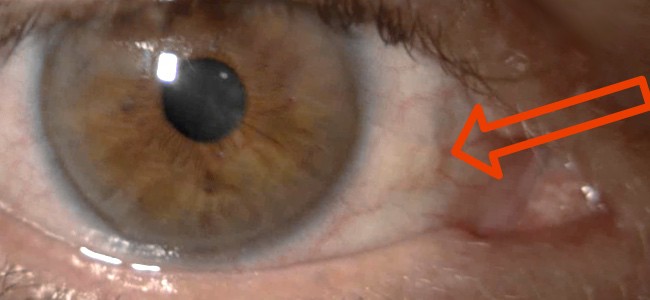Yellow differentiated spots Pinguecula on your eyes are collagen deposits in the upper layer of the conjunctival tissue. These yellow spots on the eye are usually found to the right or left of the cornea and are slightly raised. It can occur when the conjunctiva is exposed to excessively hot, dry, windy climates and high UV exposure.
The risk of developing an eyelid pinguecula increases with age. However, pinguecula is not tied to contact lens wear but can change due to exposure of the contact lens rim to the conjunctiva. Therefore, it is necessary to regularly have one’s eyes and contact lenses checked by a specialist in order to make any necessary changes at an early stage.
The yellow spots on the eye may look unusual, but usually do not cause symptoms. However, care should be taken not to irritate the affected areas of the eye. This means that ideally, sunglasses are worn, which also provides very good protection from wind and sunlight.
Likewise, care should be taken that contact lens wear does not irritate the located areas. This is because soft contact lenses usually lie with their edge directly on the pinguecula and can thus lead to irritation due to constant friction. An optician or ophthalmologist can check with a contrast medium whether the yellow areas on the eye (pinguecula) are irritated. This is because cell defects quickly show up here.
If irritation occurs, the geometry of the contact lens must be changed. Read more to learn how contact lenses can be optimized for wear in combination with pinguecula.

What to Do When Recognizing Yellow Spots in Your Eye?
- Reduce exposure to UV light. Wear good sunglasses
- Use contact lenses that with an optimized to wear in combination with pingecula
- Make sure the yellow spots are listed in the documentation of your optician or ophthalmologist
To reduce the risk of pinguecula or increased growth of an existent yellow spot in your eye use sunglasses. They cover your eyes from the sunlight. This does not only include visible sunlight: Even without direct sunlight – for example under cloudy skies – your eyes are exposed to UV radiation. The radiation is particularly intense at the sea and in the high mountains.
Here, sunglasses that have a sportier cut and also cover your eye area from the side are highly recommended. So the protection lies in not irritating the yellow areas. In addition to UV light, irritation can also occur due to drying or the wrong choice of contact lenses.
Here, care should be taken that the edge design of the contact lenses is adapted to the shape of the yellow areas of the eye. It is possible, for example, to order the contact lens smaller to avoid contact altogether.
However, the edge profile of the contact lens can also be made flatter to reduce mechanical stress. There is also the possibility of milling a scleral lens or a lens made from an impression. It is important to avoid that the contact lens rubs against the yellow areas.
Symptoms of Pinguecula
When the pinguecula grows large enough, the surface is no longer so already flat. Then the tear film may not be able to spread around it to wet the entire surface of the eye. This can lead to symptoms of dry eyes. This then often leads to a burning sensation or stinging. Dry eyes can also cause blurred vision and a “foreign body” sensation. Classic symptoms are the following as soon as the yellow spots become more noticeable:
- Eye dryness
- Foreign body sensation
- Redness of the eyes
- Itching
To prevent dry eye, care should be taken to ensure that the wetting of the tear film is optimal. Your optician or ophthalmologist can check the tear film under the microscope and tell you whether it is optimal in terms of quantity and composition. If it is not, he or she can work with you on measures to improve the tear film. This could also reduce the symptoms of yellow spots.
If non-investment measures are not sufficient to relieve symptoms, surgery may also be performed to reduce or remove pinguecula. This operation is usually performed when the discomfort is great due to the yellow spots.
Grading Scale for Pinguecula After CCLRU Standards
| Grading | Level of Growth |
| 0 | not present |
| 1 | slightly raised surface <0.5mm |
| 2 | slightly raised surface 0.5- 2.5mm |
| 3 | raised yellow surface |
| 4 | larger area in the palpebral fissure region |
How Is Pinguecula Diagnosed?
The palpebral fissure stain is usually diagnosed during a slit lamp examination. By using a microscope, the attending physician can see here exactly whether a yellow spot is present or whether a new suspected diagnosis must be made. In this form of examination, additional aids such as eye drops or similar are usually not necessary, as the clinical picture of pinguecula is very characteristic and can be recognized accordingly quickly.
